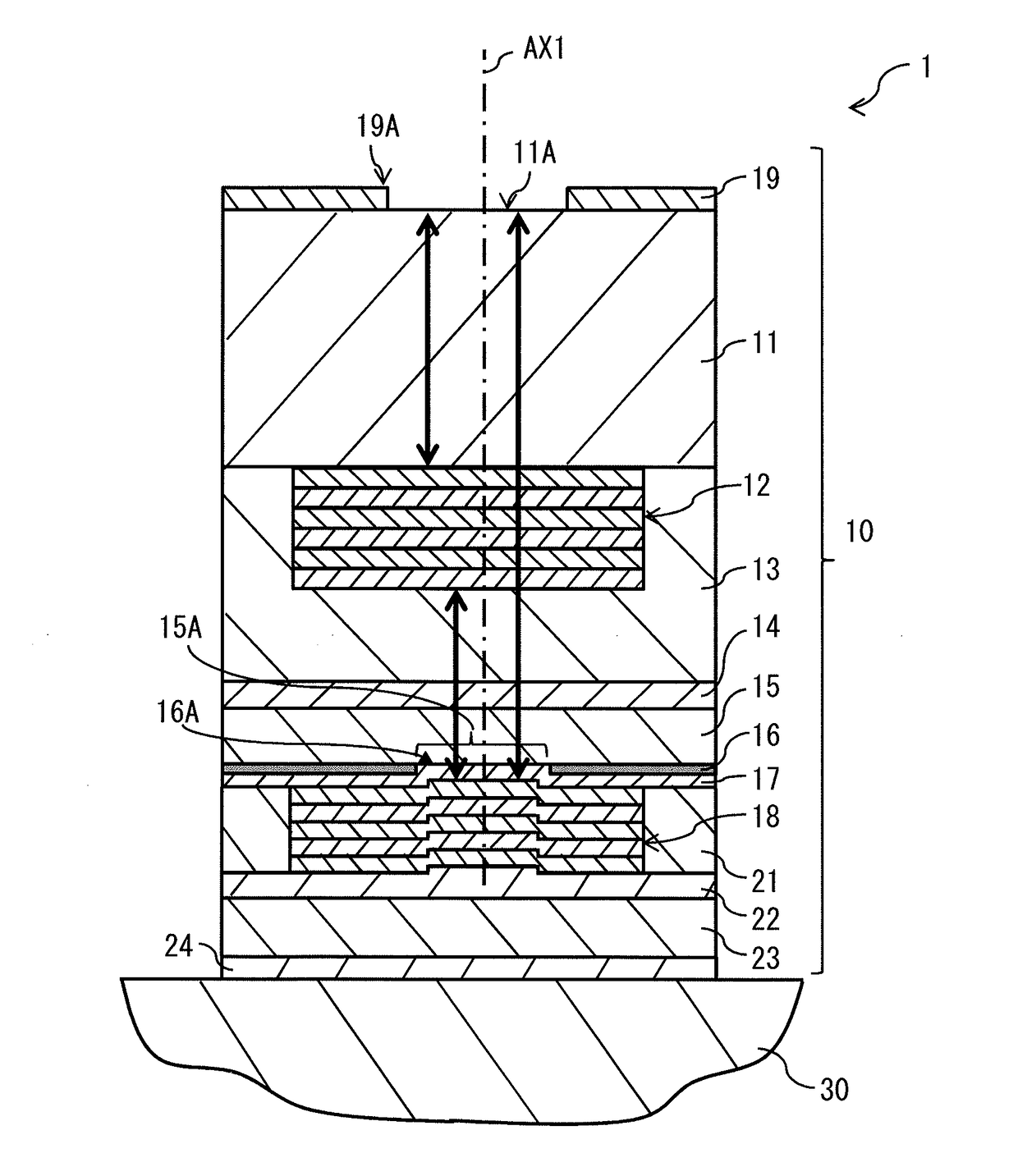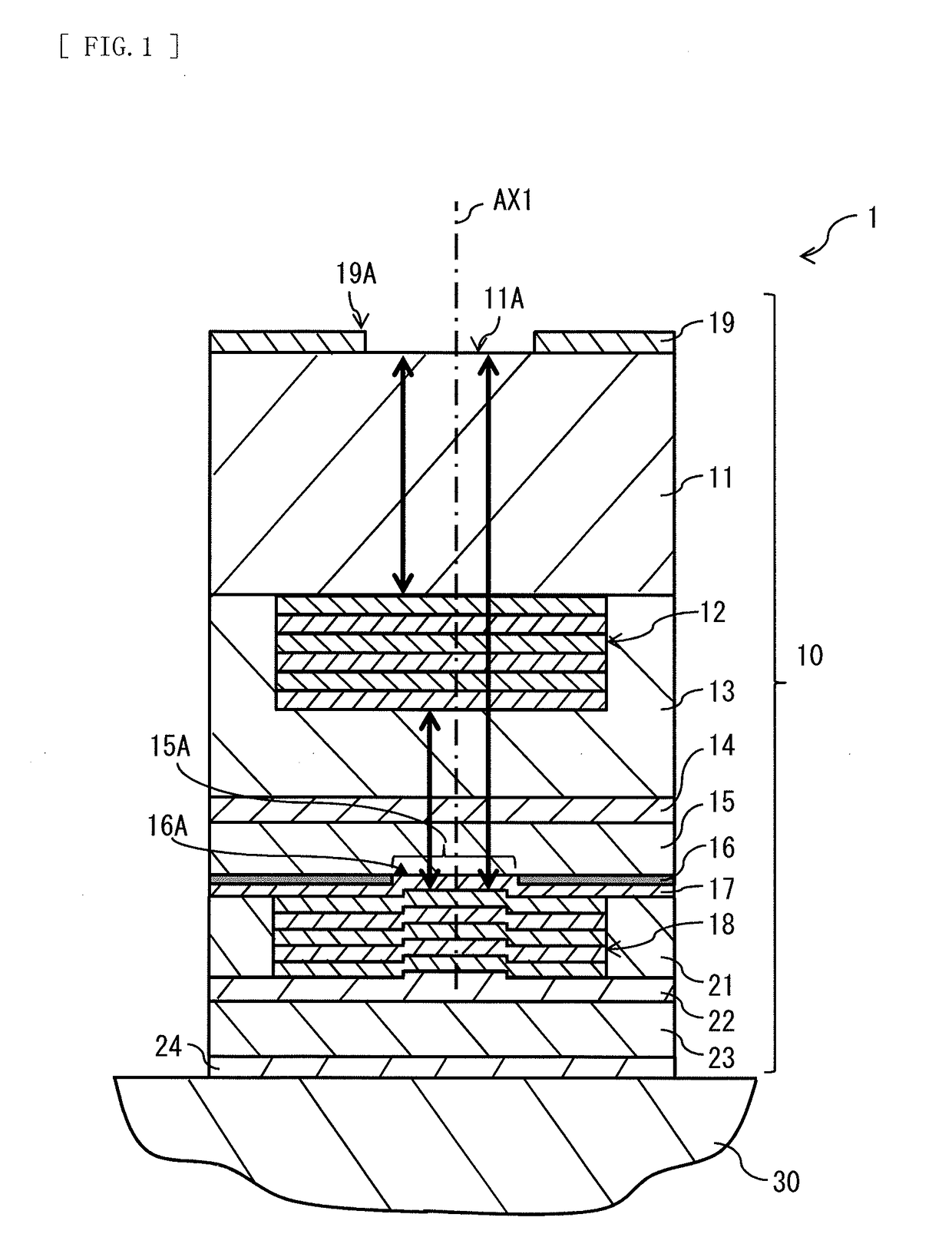Surface light-emitting laser
a surface light-emitting laser and nitride-based technology, applied in semiconductor lasers, laser details, electrical devices, etc., can solve the problems of no region available for formation, large difficulty in accurately aligning the two optical axes, optical elements, etc., to accurately determine the position of the light output surface. , the effect of accurate determination
- Summary
- Abstract
- Description
- Claims
- Application Information
AI Technical Summary
Benefits of technology
Problems solved by technology
Method used
Image
Examples
first embodiment
1. First Embodiment
Configuration
[0062]FIG. 1 illustrates an example of a cross-sectional configuration of a surface-emitting laser 1 according to a first embodiment of the technology. FIG. 2 illustrates an example of a top-side configuration of the surface-emitting laser 1. FIG. 3 illustrates an example of intensity distribution of light to be outputted from a light output surface 11A on a top surface of the surface-emitting laser 1. It is to be noted that FIGS. 1 to 3 are represented schematically, and dimensions and shapes illustrated therein are different from actual dimensions and shapes. In explanation of a configuration of the surface-emitting laser 1, an “upper side” refers to side of the light output surface 11A, and a “lower side” refers to side of a sub-mount section 30 to be described later.
[0063]For example, as illustrated in FIG. 1, the surface-emitting laser 1 includes a laser element section 10 and the sub-mount section 30. In the surface-emitting laser 1, the laser e...
modification example a
[0090]In the above-described embodiment, the multi-layer film reflecting mirror 12 is a dielectric multi-layer film reflecting mirror; however, the multi-layer film reflecting mirror 12 may be a semiconductor multi-layer film reflecting mirror that is formed through the epitaxial growth, as illustrated in FIG. 5, for example. FIG. 5 illustrates a modification example of a cross-sectional configuration of the surface-emitting laser 1 according to the above-described embodiment.
[0091]In the present modification example, the multi-layer film reflecting mirror 12 is a nitride-based semiconductor multi-layer film reflecting mirror that functions as the DBR. A conductivity type of the semiconductor multi-layer film reflecting mirror configuring the multi-layer film reflecting mirror 12 is equivalent to a conductivity type of the semiconductor layer 11. The multi-layer film reflecting mirror 12 is configured in such a manner that two or more kinds of nitride semiconductor layers made of ni...
modification example b
[0093]In the above-described embodiment and modification example A, the top surface of the semiconductor layer 11 is a flat surface; however, a convex mesa portion 11B may be provided on the top surface of the semiconductor layer 11, as illustrated in FIGS. 6 and 7, for example. FIG. 6 illustrates a modification example of a cross-sectional configuration of the surface-emitting laser 1 according to the above-described embodiment. FIG. 7 illustrates a modification example of a cross-sectional configuration of the surface-emitting laser 1 according to the modification example A.
[0094]A top surface of the mesa portion 11B serves as the light output surface 11A, and the electrode layer 19 is provided at a region corresponding to a base of the mesa portion 11B. In the present modification example, in a manufacturing process, after the top surfaces of the semiconductor layers 11 and 41 are formed, the mesa portion 11B is formed at a position corresponding to the light output surface 11A o...
PUM
 Login to View More
Login to View More Abstract
Description
Claims
Application Information
 Login to View More
Login to View More - R&D
- Intellectual Property
- Life Sciences
- Materials
- Tech Scout
- Unparalleled Data Quality
- Higher Quality Content
- 60% Fewer Hallucinations
Browse by: Latest US Patents, China's latest patents, Technical Efficacy Thesaurus, Application Domain, Technology Topic, Popular Technical Reports.
© 2025 PatSnap. All rights reserved.Legal|Privacy policy|Modern Slavery Act Transparency Statement|Sitemap|About US| Contact US: help@patsnap.com



